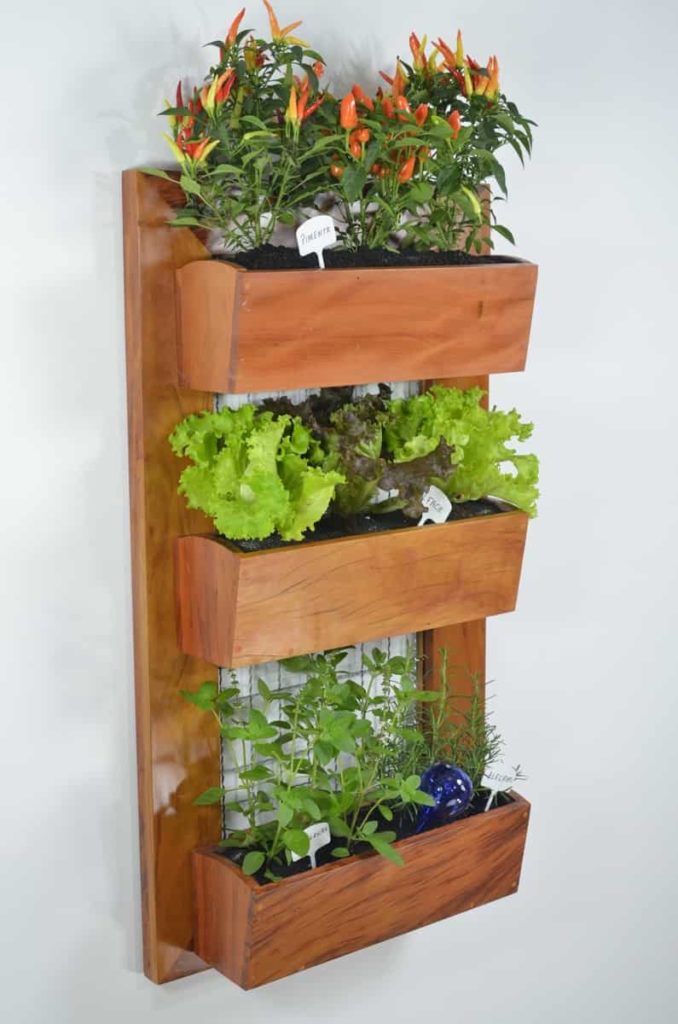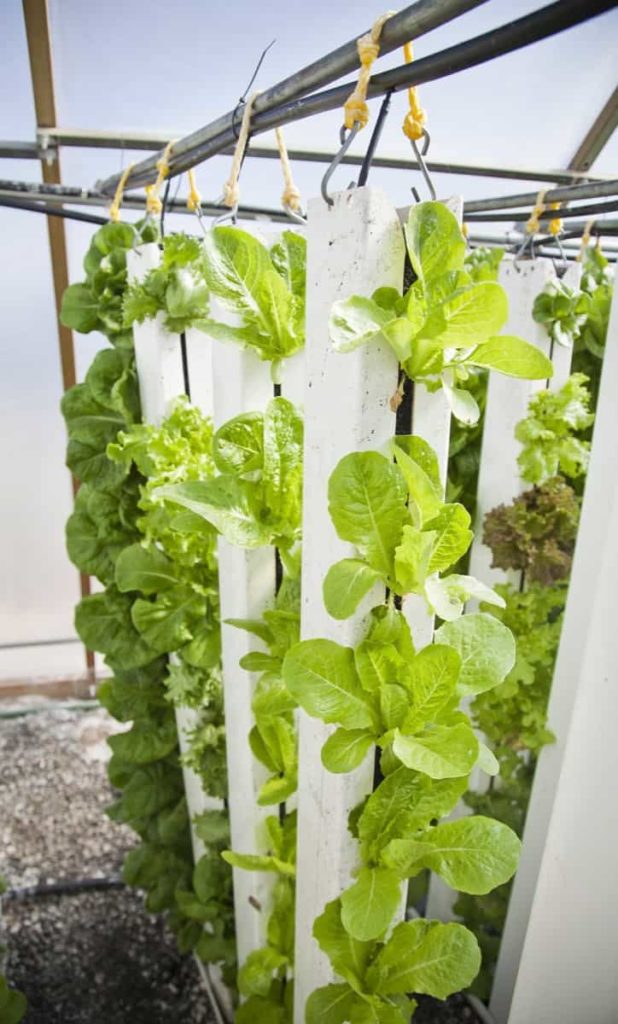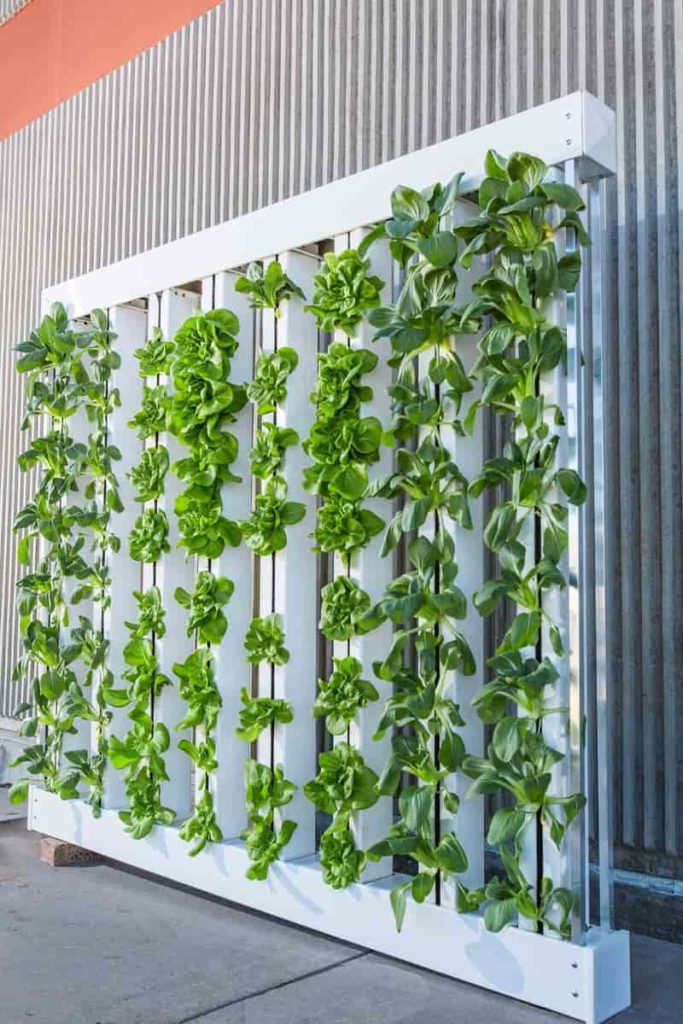A vertical vegetable garden is a simple method to boost growing space, reduce insect and disease problems, and beautify balconies and terraces. Use structures like trellises, stakes, and obelisks in a veggie plot. These structures will support tomatoes, cucumbers, squash, gourds, peas, and pole beans. With creative thinking, plants can grow up on walls and fences or create vertical garden spaces with hanging baskets or pallets.
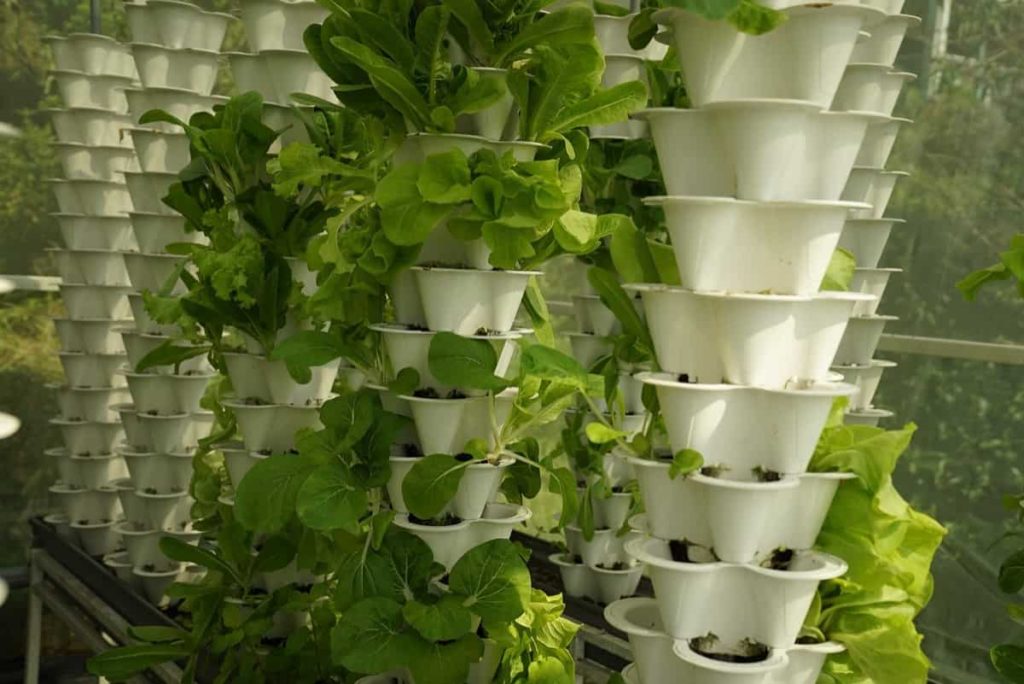
Vertical gardening allows more sunlight, air, and pollinators to reach the plants. This added sunlight, airflow, and pollinators also increased production. By doing vertical gardening, it is possible to harvest extra produce more easily because there is no need to search for fruits and vegetables.
Top 29 vertical vegetable garden ideas for beginners
Upcycled vertical planters
Vertical planters utilize the maximum surface area to grow plants, making the most use of outdoor space. Vertical planting is also a good option for people who want to grow food. A vertical planter is anything that can hang on a wall and can hold soil. Drainage is a simple task to create with a drill but even easier if you use something designed to allow airflow. Reusing trash bins as planters to dress up a wall or fence is a good idea. The planters require rope or twine. Paint them in a bold hue to amp up the look.
Vertical plant stand
Choosing plant stands for indoor use can be fun since many creative ways to display indoor plants. Use a stand to elevate plants behind sofas or in the corner of the room. This idea is especially effective if the houseplant is small. Elevating a specimen plant will make more of a statement.
Plant stands are constructed from many materials such as wood, wrought iron, powder-coated metal, bamboo, and even wicker. If a room does not have any or enough natural light, choose a plant stand with built-in grow lights. Use an old footstool, or even an old bar stool, as a plant stands for a single plant.
Potted hanging planters
A hanging basket is a container suspended from ceilings used for growing plants. Typically they are hung from building ceilings, where garden space is very short, and from street furniture for environmental enhancement. They may also be suspended from free-standing frames, called hanging basket trees.
One of the easiest ways for vertical garden ideas to recreate is when hanging planters are used. Choose patterned ceramic holders, and tie them securely with rope. Eggplants, strawberries, small peppers, cherry tomatoes, and lettuce are all good candidates. Chives, mustard greens, cabbage, and many herbs also can be grown in hanging baskets.
In case you missed it: A Guide to Understand Vertical Urban Farming/Gardening: Check How this Helps Beginners
Plastic gutter vertical vegetable garden
Gutter gardens are one of the creative ways to make use of vertical space outdoors. The concept is simple, and gutters function as long and shallow pots. They are only suitable for plants that do not need much-growing space. They are conducive to long, narrow spaces. By implementing some gardening ideas, many edibles can grow on a patio or porch with a vertical vegetable garden.
Any gardener can create a vertical gutter garden. These gutters can be attached directly to walls and fences or hung with chains. Make holes in the bottom of the gutters to make drainage. Add caps at both ends and then fill with potting soil. The best plants to grow in gutters include curly parsley, alpine strawberries, lettuce, spinach, tomatoes, and nasturtiums.
Incorporate a salad tower in the garden
Growing plants vertically is a smart idea when space is tight. A salad tower at home is a cost-effective solution and saves space. It is fun to make and should give something to pick from within a few weeks after planting in the salad tower. It is easy to make; this is a cylinder built from a sturdy wire mesh, lined in plastic, and filled with soil.
To build, bend a section of metal mesh into a cylinder and line it with a garbage bag or a large plastic sheet. Fill this bag with moist potting soil. Make side holes, cut an X through the plastic sheet, and sow the seeds into the cylinder. Water well and feed them every two weeks with liquid organic food. Mix and match arugula, spinach, lettuce, chard, Asian greens, and kale for a tapestry of greens.
Make use of the windowbox wall
One of the simple ways to grow food vertically is to secure window boxes or individual pots to fences and walls. Growing plants in window boxes put them at eye level, which gives a different perspective than having them in the garden. Plant with compact herbs, vegetables, and strawberries can be grown in window boxes. Experienced gardeners can train climbing vines around the window frame for an authentic look.
Amateur crafters can make their planters using small wood pieces. Create the base to rest the plant, then hammer the creation to the fence or wall. Feed the window box plants with fertilizers regularly to keep them growing. Before planting the plants in the boxes, add a slow-release fertilizer to the soil. After the pellets disappear, fertilize weekly with a liquid fertilizer.
Growing herbs and vegetables in a hanging shoe organizer
Try to grow herbs and leafy greens shoe organizers hung to the wall or ceilings. It is one of the good vertical vegetable garden ideas to try. Using a shoe organizer means built-in compartments for the herbs. This idea eliminates the need to measure the distance between each group of seeds. Reuse an old shoe organizer as planters. Hang them on the fence or wall, and fill the compartments with soil to display ferns, vines, and other forms of greenery. This trend keeps gardening simple and is a great way to enter the world of outdoor gardening.
Hanging globe planters
Globe Tree Planters are spheres shaped and made of steel and create a playful, unusual streetscape. If required, they can be finished with a double-layered powder coating. The smaller versions comprise half a sphere. Hanging globe planters are one of the perfect ideas for growing herbs and small veggies in a small space. These planters give an elegant look by Showcasing an array in one room section or hanging them from the porch ceiling.
In case you missed it: Top 31 Vegetable Garden Ideas at Home: Check How this Guide Helps Beginners
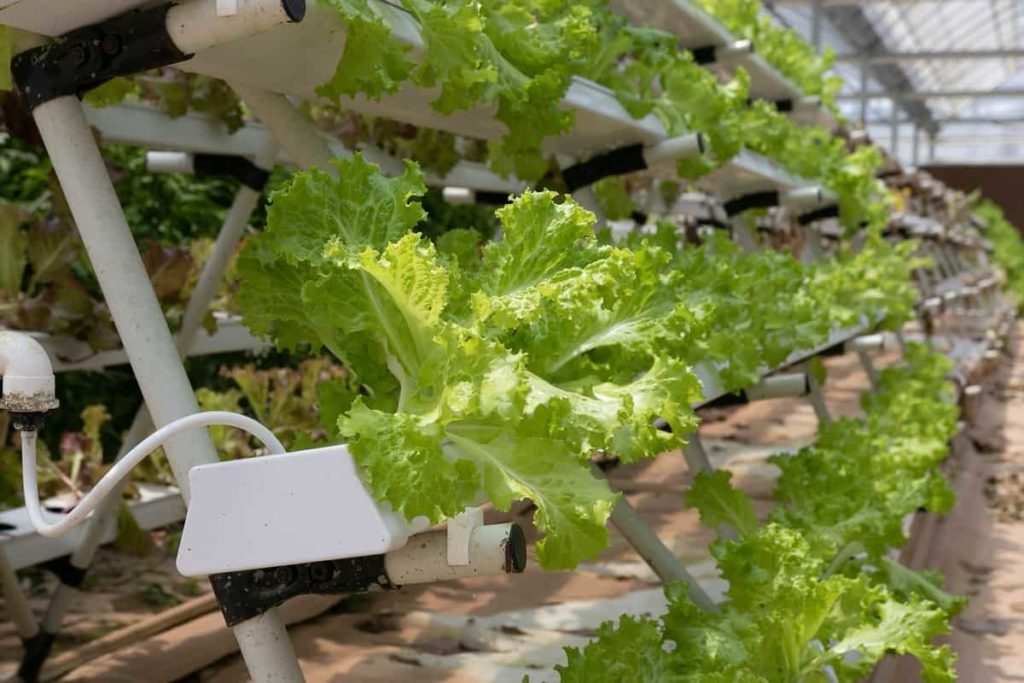
Hanging water bottle planters
Empty water bottles can be used as planters to plant the veggies when the garden space is limited. Collect the empty bottles or cartons, cut them into two halves, and open the bottom part to place plant and paint faces on the front side of the bottle. Make small holes at the bottom for better drainage.
Use the rope to hang them in the indoor or outdoor space like a pole, stick, or fence. Follow this idea for growing leafy vegetables and small herbs. This vertical garden idea is made by cutting the bottles along their length in a grid along an interior wall, filling them with substrate and herbs.
Used shutters to grow small shrubs
Shutters planted with veggies are alluring for building green walls or wall gardens because they are extremely hardy. The plants planted in these shutters do not need a lot of water, sun, space, or fertilizer and, like most indoor plants, have some great benefits. Use new or purchased shutters to grow vegetable plants. Take the support by lean them against the wall and filling the slots with soil. Then sow the seeds in that soil and water them till they grow.
Hanging diamond planters
The Diamond Planter is a planter planted with many types of plants. The planter may be brown in color and diamond in shape. Inside this planter, plant the vegetable plants you want to grow. Each plant is different in shape and size. This idea is ideal for single small veggie plants, and It is easy to hang these planters having plants in any part of the room without taking up too much space.
Use a bird bath to implement a small vegetable garden idea
One of the best ideas for implementing a vegetable garden for growing vegetables in a short space is planting them in a bird bath. Fill the bird bath with soil, pebbles, moss, herbs, and blooms to transform it into a miniature garden. Arrange the plants, leaving space for growth but enough to make them feel lush and full, and this idea best suits mint, coriander, and lemon grass shrubs. Plant a taller plant in the middle, trailing plants on the edges so they can spill over.
Hanging colanders
Reuse that old colander, muffin tray, or vintage tin by taking it outside and planting it up with herbs and salad greens. These containers are also used to grow strawberries and even grow ornamental with spring-flowering bulbs or colorful polyanthus. Whatever the plants grow in a pot will also grow in a colander like the one kitchen utensil that comes with ready-made drainage holes.
Ladder garden
Incorporating ladders in the vegetable garden will add a fun architectural element to the garden, and training plants up a ladder gives more space in the garden. Depending on the ladder size, they offer a lot of room and a large area for the plants to grow. A range of tools and ladders are available to make reaching high branches easier and safer if you are planning to grow to prune back shrubs and trees this winter. A short wooden ladder is a perfect spot to create a tiered garden. Fill up each rung with planters having your favorite vegetable plants.
Use scrap wood boxes as a vertical planter
Scrap wood boxes can be used as a planter to grow plants. After measuring, cutting, and securing the corners together in a box form, fix these boxes rigidly with hooks inserted into the compound wall. Fill these boxes with soil, sow the seeds, or plant your favorite vegetable plants.
In case you missed it: How to Start Eggplant/Brinjal Farming in Malaysia: Check How this Guide Helps to Grow Eggplant
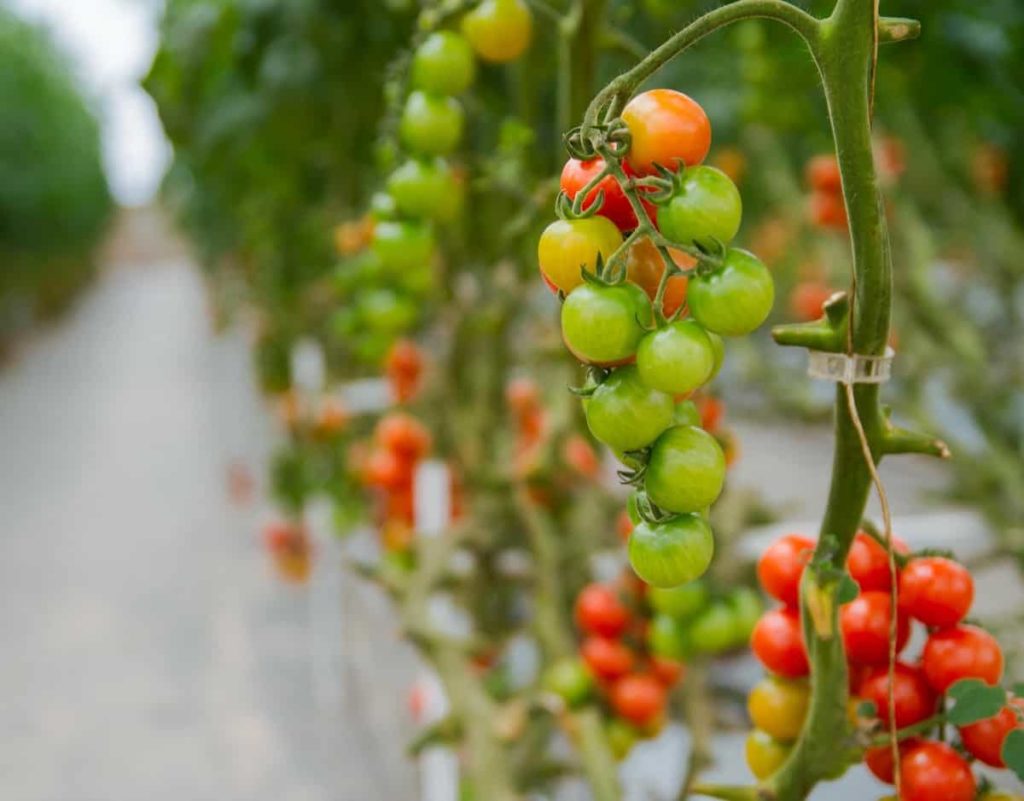
Stacked recycled tires
Making a vertical tire planter and growing vegetables is a unique idea to recycle old tires. It is easy to do as well. Turn tires into colorful flower pots for the garden. To plant vegetable plants in tires, you must consider installing a tire flower bed wall. It adds structural integrity to the garden set-up.
Tires make for an appealing planter option and help plant many plants to form a beautiful flower bed wall. First, paint them with any preferred color. Use cardboard as a base to keep soil from spilling, and plant your planned vegetable plants inside. Stack them on top of others for a layered and authentic look.
Try hanging mason jar planters
Transform empty and old mason jars into perfect hanging planters. Hang them to wood beams on the ceilings with rope, ensuring they are securely fastened around them to prevent them from falling. Some suitable options for a mason jar herb garden include cilantro, rosemary, dill, mint, chives, and thyme. This idea will not work with deep-rooted vegetables such as peppers and beans, but most herbs will be well suited as long as their roots are shallow.
Vertical fence garden
A fence is a practical way to protect the garden from critters, but it is also fun to add a little personality to the house. Vinyl fencing is one of the good garden choices because it is naturally durable and weather resistant. It will not be required to be painted or stained over time because it is designed to maintain its color with no maintenance. Train vines to climb upwards on the fence. Wrap them through the squares and use hooks to keep them if they fall. Cut and prune them so they grow in the direction you like.
Use upcycled wood pallet
Old wooden shipping pallets can be used as a supporting structure to make gorgeous, rustic vertical gardens with room for many plants in a small space. Even apartment residents with nothing more than a balcony can use this idea to grow edibles, beautiful annuals, or both. Pallets should be slightly modified before they can be used as planters, but they will make an ideal base for vertical gardens. This design uses hanging cup holders as planters and arranges them in a fun pattern on a wooden mount. They can be left laying flat on the ground to be used as convenient raised beds.
Hydroponic vertical gardening
Hydroponics is growing plants without soil horizontally or vertically, where mineral nutrients are provided through the water. Hydroponic systems implemented for vertically growing plants are known as vertical hydroponics. The practice is also known as Tower hydroponics. The nutrient-rich water is fed from the top and collected at the bottom. Grow tomatoes vertically in limited space in these hydroponic towers. Fast-growing herbs are the best options for tower hydroponics, including leafy greens like lettuce, kale, chard, mustard greens, collard Greens, and spinach.
Garden towers
Tower gardens use vertical space instead of horizontal planting in traditional garden settings. They require support structures, plant openings, and a watering or drainage system. Tower garden ideas are endless, and creating a unique homemade garden tower can be fun and easy.
Fruiting vegetables like tomatoes, eggplants, bell peppers, chili peppers, squashes, and cucumbers will grow exceptionally well on Tower Garden. However, a grow cage or an outside structure is required to support the weight of the vegetables. Lettuce can be grown vertically in a lettuce tower. A wide range of herbs or leafy greens in a stacked pot can be grown in garden towers.
PVC pipe vertical garden
Designing a PVC home garden can be interesting and innovative. A PVC pipe can be used, and it is a magical material that can make vertical, space-saving, and self-irrigated clean gardens for fresh fruits and veggies. Used PVC pipe created a vertical wall garden perfect for growing herbs, greens, and small veggies like radishes or globe carrots. These PVC pipes can also be used as planter frames or watering systems.
In case you missed it: Texas Vegetable Planting Calendar (TX): Month Wise Chart, Zone 6, Zone 7, Zone 8, and Zone 9
Hanging vegetable gutter garden
Gutter gardening creates a small garden by planting flowers, vegetables, or herbs inside rain gutters. Gutter gardens will add color and a touch of the outdoors to places, like small terraces or apartment balconies, that will not have enough space to accommodate real gardens. A gutter garden is best suited for growing salad vegetables.
Small peppers, lettuce, spinach, and other leafy vegetables thrive in small spaces. Tomatoes and strawberries are also ideal for gutter gardens because these fruits do not need much space. Mint, basil, and rosemary are easy to cultivate in a gutter garden. These herbs grow quickly and easily and do not need much attention.
Hanging basket garden
A hanging basket will not take up ground space but can offer a bumper crop of sweet strawberries or tumbling tomatoes. Look for everbearing or day-neutral strawberry types for the longest harvest. Hang the basket to the ceilings in a sheltered sunny spot, and water and feed often. Grow vegetables vertically in a hanging gutter garden and save floor space.
Trellis to grow vegetables
A trellis is generally a garden ladder that is created as a structure to climb vines that grow vertically. It is one of the best structural tools that help save garden space and act as a support for climbing plants. It is often suggested for a few types of plants to let grow on a trellis. It works well for indoor and outdoor plants that may otherwise take up a lot of space.
Trellis can be made with different materials. It is mainly an open framework that allows plants to grow upwards and spread across. So it can very well be made of natural materials like wood, straw, and bamboo, but it also suffices with metals like iron and even plastic.
Raised bed ideas
Raised bed gardening means growing plants in soil that is higher than the ground. Most commonly, this gardening is done with some enclosure or frame made of wood, stone, or even repurposed material like old dressers. Raised beds have very few limits. Attach wooden boxes to the walls or fences and use them as small raised beds. Fill these boxes with nutrient-rich soil and sow the seed or plant your vegetable plants. These will look good all year long, with annuals filling in as perennials.
Try cedar planters in vertical gardens
This space-saving vertical planter allows for the growth of an abundance of herbs and edible plants with minimal maintenance. It includes a drip-irrigation system that promotes plant growth and conserves water by directing it straight to roots and reducing evaporation.
It is a space-saving vertical planter on a stand with a small footprint, is ideal for compact spaces, and Is lined with filter fabric to keep soil in a while, allowing water to drain. They are best suited for growing herbs, but this would be perfect for lettuce, spinach, radishes, carrots, cherry, and tomatoes.
Build a straw bale garden
A straw bale can be one of the best growing mediums, and a straw bale garden is a raised bed that houses the soil, compost, and plants inside the straw bale. Straw bale gardening is one of the best ways to grow herbs and vegetables and can also be used to plant some ornamental plants. It’s economical, easier, and great for people with mobility issues.
In case you missed it: Top 47 Home Garden Ideas for Small Spaces: Check How this Helps Beginners
Stair Step Vegetable Garden
This stairstep planter is a great vertical gardening idea. It is a simple project, one that can easily do in one day. Used wooden boxes are placed one over the other in a zig-zag way, and fill these boxes with soil with enough moisture. Sow the seeds or plant the vegetable plants that you wanted to in these boxes.
This idea does not require making any special arrangements for the water drainage in this system. Excess water can be escaped through small gaps between the wooden pieces. Herbs like lettuce, basil, coriander, and mint can be grown in these containers. Vertical gardening is not only popular these days but also has aesthetic, physiological, economic, and environmental benefits.
- A vertical garden saves space.
- A vertical garden helps to plant a variety of plants
- Vertical gardens will give healthy vegetation.
- Vertical gardens are stress relievers
- Sheep Farming Business Plan for Beginners
- Aquaponic Farming at Home: A Step-By-Step Guide
- Profitable Village Farming Business Ideas in 2024
- High-Yield Aquaculture: Fast-Growing Fish for Farming
- Effective Fish Pond Construction Techniques for Beginners
- Irrigation and Water Management in Pineapple Farming
- Blossom to Harvest: Mastering Flowering and Pollination in Papaya Farming
- Pig Fattening Essentials: From Selection to Sale for Beginners
- Raising Wagyu Cattle: A Complete Guide for Premium Beef Production
- Soil Types and Their Water Holding Capacity
- Optimizing Irrigation Schedules for Coconut Groves for Enhanced Yield
- Espresso Your Garden: Coffee Grounds for Healthier Acid-Loving Plants
- The Best Soil Mix for Snake Plants: How to Mix Your Own Snake Plant Soil
- Green Thumb Success: Expert Tips for Cultivating Greenhouse Beans All Year Round
- Bloom All Year Round: The Ultimate Guide to Indoor Hyacinth Care
- Eco-Friendly Gardening: How to Make Liquid Fertilizer from Kitchen Waste
- Ultimate Guide to Grow Anise in Pots: Explore Seed Propagation to Harvesting
- Guide to Raising Chester White Pigs: Discover Breed Facts to Growth Management
- Mastering the Elegance: The Ultimate Guide to Weeping Cherry Tree Care, Planting, and Maintenance
- Ultimate Guide to Planting Garlic in Grow Bags: Growing Strategies for Beginners
- How to Fix Spider Plant Leaf-Related Problems: Natural and Organic Remedies
- 10 Reasons Why Your Tulsi Plant is Shedding Leaves: Home Remedies and Solutions
- Optimizing Growth and Yield: The Advantages of Palm Bunch Ash Fertilizer
- Utilizing Neem Oil Extract as a Natural Pesticide for Hydrangea
- From Soil to Harvest: Various Ways in Which Farmers Can Use AI Tools
- Steps to Encourage and Induce Citrus Flowers: A Comprehensive Guide
- How to Fix Snake Plant Leaf-Related Issues: Natural and Organic Remedies
- Transform Your Garden into a Fragrant Oasis with Raat Ki Rani (Night Blooming Jasmine)
- Discover the Ideal Chicken Breeds for Philippine Farms
- How to Create a Poultry Egg Farm Business Plan for Profits
- Grow Lemon Cucumbers Like a Pro: Insider Techniques for Bountiful Yields
- Ultimate Guide to Caring for Your Pink Princess Philodendron: Tips for Thriving Variegation
- Areca Nut Profit Per Acre: Calculating Yield and Cost of Cultivation
- How Kaveri Chicken is Becoming a More Profitable Breed in Indian Backyards
- Transform Your Barn: 9 Steps to Convert a Horse Stall into a Chicken Coop
- Exploring Suffolk Sheep Disadvantages with Limitations and Challenges

